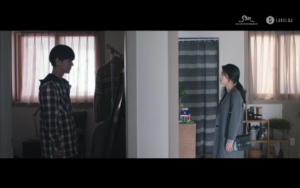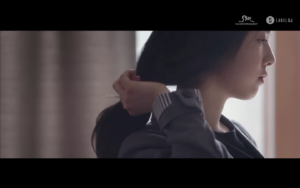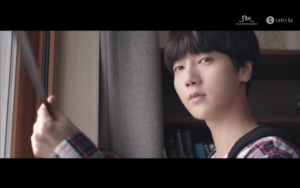 Yesung, Super Junior’s main vocalist, recently made his solo debut with “Here I am.” Super Junior is a veteran group that needs no introduction. Though their presence in the K-pop industry is not as prevalent as it once was, the achievements of the group in entertainment cannot be ignored. As several members are currently serving in the military, individual members are given the time to stand out and hone the individual skills.
Yesung, Super Junior’s main vocalist, recently made his solo debut with “Here I am.” Super Junior is a veteran group that needs no introduction. Though their presence in the K-pop industry is not as prevalent as it once was, the achievements of the group in entertainment cannot be ignored. As several members are currently serving in the military, individual members are given the time to stand out and hone the individual skills.
Overall, “Here I am” is emotional and adequately displays Yesung’s vocal prowess. The music never overpowers his voice, and instead allows it to stand out. It’s a nice, soothing song that one might expect from him. It seemed obvious that Yesung would start off his solo debut with a ballad, as it’s material he is no doubt comfortable with. After all, he has contributed to numerous OSTs ,and he is a part of Super Junior’s ballad subunit Super Junior K.R.Y.
Regardless, it would have been more interesting to see something a little different from him. There are so many good singers out there that it seems as though songs like these get easily passed by, and it would be more interesting and surprising if Yesung decided on something more attention-grabbing to assert his relevance in the sea of new artists.
After all, a solo debut is a construction of an identity outside of the group, a platform for singers to explore and do things that they can’t do while in the group. But if Yesung is able to sing ballads in K.R.Y. and in OSTs, is his solo debut really that much of a step in a different direction or a step toward growth? At the same time, we do have to give Yesung props for participating in both the lyric-writing and composition of the song.
While the song itself is not particularly striking, it is straightforward. The lyrics portray a fairly straightforward story of a lover pining after and trying to win back their ex.
The video appears to be similarly straightforward. It starts with Yesung closing his eyes as we are thrown into a flashback sequence in which Yesung packs away items into a box. Soon after, three women (one is seemingly a potential buyer of the apartment and another is probably a real estate agent) enter the dwelling. The last girl that enters turns out to be Yesung’s past lover. The video then veers further into flashbacks of when the two lovers were happily together. These scenes are contrasted with the near-present, in which the ex-lovers awkwardly navigate around one another in the apartment, and what seems to be the actual present, in which the female mercilessly walks past and away from him. However, in a scene that assumedly takes place in Yesung’s imagination (since he is wearing the black outfit from the present and she is wearing what she wore in the near-present), the female turns back and the two lovers are given a second chance at clearing the air.
Though the video is slow-going, the director makes deliberate choices in every scene, resulting in a music video rife with symbolism.
 In particular, this symbolism clearly defines the romantic relationship between the two protagonists: Yesung still needs the female because he needs her to turn off the faucet for him, but the female doesn’t need Yesung because she doesn’t need someone to tie her hair up for her. When the two encounter one another in the present, she has her hair down, indicating that she can now put her hair down or tie it up to her own liking. While she did enjoy Yesung tying her hair in the past, she no longer needs him to do it for her. She has grown out of the relationship and left Yesung behind. In contrast, Yesung is acutely aware of her habits: not wearing her shoes properly and not tying her hair properly. He relates these habits to events of the past, which he dwells upon. This is indication that he is stuck in the past, while the female lead seems to have moved on – even though she does appear to be broken up about it. She can take care of herself now.
In particular, this symbolism clearly defines the romantic relationship between the two protagonists: Yesung still needs the female because he needs her to turn off the faucet for him, but the female doesn’t need Yesung because she doesn’t need someone to tie her hair up for her. When the two encounter one another in the present, she has her hair down, indicating that she can now put her hair down or tie it up to her own liking. While she did enjoy Yesung tying her hair in the past, she no longer needs him to do it for her. She has grown out of the relationship and left Yesung behind. In contrast, Yesung is acutely aware of her habits: not wearing her shoes properly and not tying her hair properly. He relates these habits to events of the past, which he dwells upon. This is indication that he is stuck in the past, while the female lead seems to have moved on – even though she does appear to be broken up about it. She can take care of herself now.
Another element of interest is the dolls that the female lead created. They originally stood by a house, which is indicative of the lovers’ shared dwelling and future. Yesung taking the two dolls that she made of them and boxing them away is similar to taking away the relationship and shared future between them. And more literally, it indicates the removal of the two lovers from the physical house that they once shared. The dolls help illustrate the reality that the relationship between the two is finally over.
 Also symbolic is the scene where the female protagonist requires Yesung’s help with the tape measurer. Though it shows that she needs help, the help is distant and impersonal. The stretching of the measuring tape only helps to emphasize the distance between the two. Though the two are not too far away from one another physically, they are miles apart mentally. Thus, it is unsurprising that there are multiple cuts of the two looking at one another from a guarded distance. Though the distance appears insignificant, it is insurmountable.
Also symbolic is the scene where the female protagonist requires Yesung’s help with the tape measurer. Though it shows that she needs help, the help is distant and impersonal. The stretching of the measuring tape only helps to emphasize the distance between the two. Though the two are not too far away from one another physically, they are miles apart mentally. Thus, it is unsurprising that there are multiple cuts of the two looking at one another from a guarded distance. Though the distance appears insignificant, it is insurmountable.
Though both the song and video do not portray novel ideas, they do still adequately portray the longing of lost love and the complicated nature of relationships. The song itself also shows off Yesung’s vocals and potential as a composer, and the clean-cut video filled with symbolism is apt evidence for a well thought-out and produced video.
What did you think of Yesung’s solo debut? Do you think sticking to a ballad for his debut is a good choice in setting the scene for his future works, or should he have attempted something more outlandish and innovative right from the beginning?
MV Rating: 4/5
Song Rating: 3.5/5


